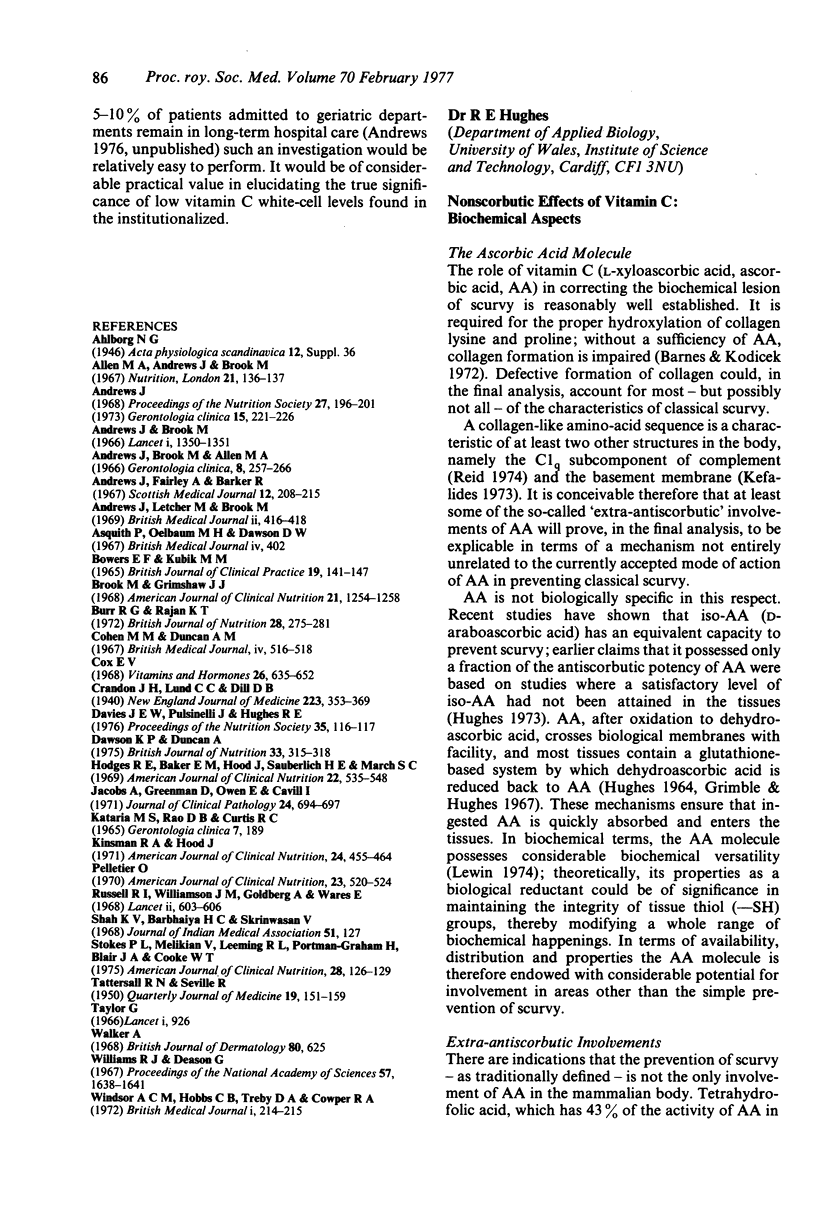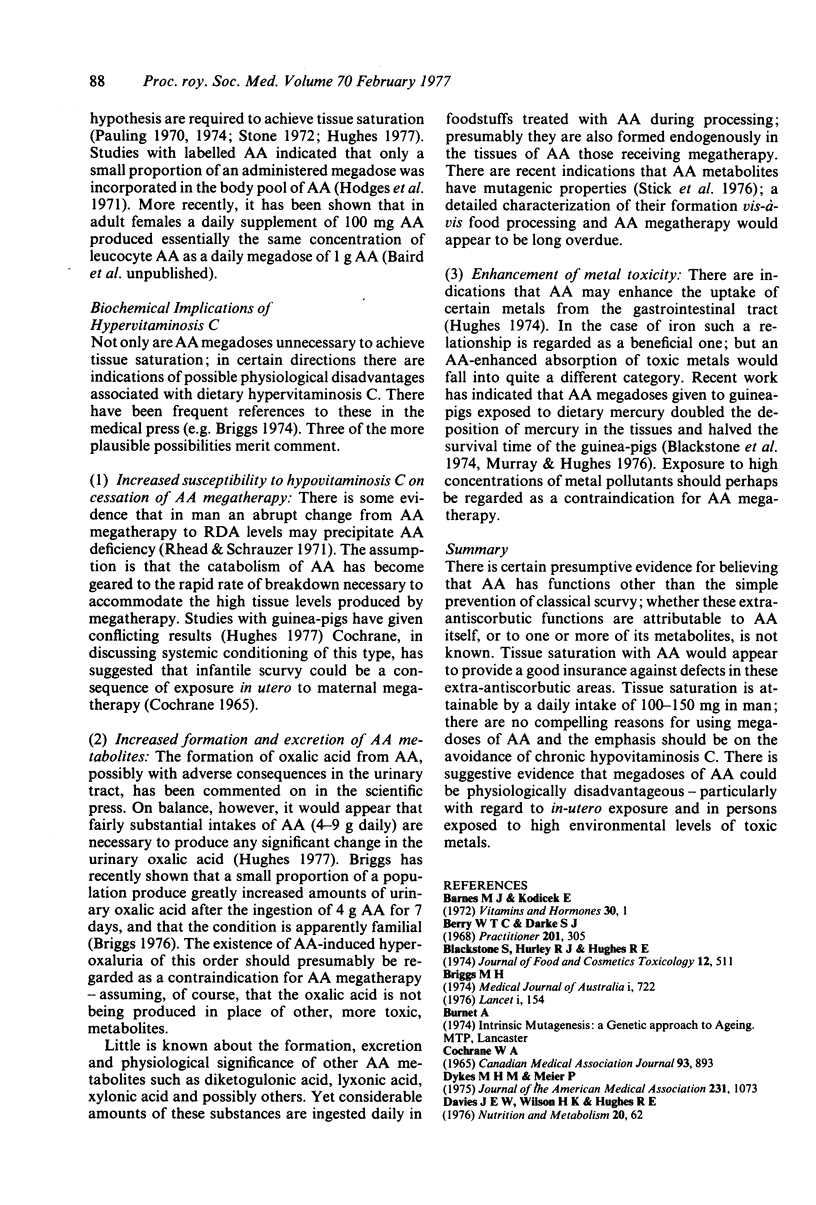Abstract
There is a certain presumptive evidence for believing than AA has functions other than the simple prevention of classical scurvy; whether these extra-antiscorbutic functions are attributable to AA itself, or to one or more of its metabolites, is not known. Tissue saturation with AA would appear to provide a good insurance against defects in these extra-antiscorbutic areas. ttissue saturation is attainable by a daily intake of 100-150 mg in man; there are no compelling reasons for using megadoses of AA and the emphasis should be on the avoidance of chronic hypovitaminosis C. There is suggestive evidence that megadoses of AA could be physiologically disadvantageous--particularly with regard to in-utero exposure and in persons exposed to high environmental levels of toxic metals.
Full text
PDF



Selected References
These references are in PubMed. This may not be the complete list of references from this article.
- Barnes M. J., Kodicek E. Biological hydroxylations and ascorbic acid with special regard to collagen metabolism. Vitam Horm. 1972;30:1–43. doi: 10.1016/s0083-6729(08)60793-1. [DOI] [PubMed] [Google Scholar]
- Berry W. T., Darke S. J. Vitamins in health and disease. Practitioner. 1968 Aug;201(202):305–313. [PubMed] [Google Scholar]
- Blackstone S., Hurley R. J., Hughes R. E. Some inter-relationships between vitamin C (L-ascorbic acid) and mercury in the guinea-pig. Food Cosmet Toxicol. 1974 Aug;12(4):511–516. doi: 10.1016/0015-6264(74)90065-0. [DOI] [PubMed] [Google Scholar]
- Briggs M. H. Letter: More vitamin C. Med J Aust. 1974 May 4;1(18):722–723. [PubMed] [Google Scholar]
- Cochrane W. A. Overnutrition in prenatal and neonatal life: a problem? Can Med Assoc J. 1965 Oct 23;93(17):893–899. [PMC free article] [PubMed] [Google Scholar]
- Davies J. E., Wilson H. K., Hughes R. E. Food intake, dietary supplements and survival time of scorbutic guinea pigs. Nutr Metab. 1976;20(1):62–66. doi: 10.1159/000175687. [DOI] [PubMed] [Google Scholar]
- Dykes M. H., Meier P. Ascorbic acid and the common cold. Evaluation of its efficacy and toxicity. JAMA. 1975 Mar 10;231(10):1073–1079. [PubMed] [Google Scholar]
- Edgar J. A. Ascorbic acid and biological alkylating agents. Nature. 1974 Mar 8;248(5444):136–137. doi: 10.1038/248136a0. [DOI] [PubMed] [Google Scholar]
- Fielding A. M., Hughes R. E. The absence of an inhibitory effect of metyrapone (2-methyl-1,2-di (3-pyridyl) propan-1-one) on hepatic microsomal hydroxylation in scurvy. Experientia. 1975 Dec 15;31(12):1394–1395. doi: 10.1007/BF01923204. [DOI] [PubMed] [Google Scholar]
- Grimble R. F., Hughes R. E. A 'dehydroascorbic acid reductase' factor in guinea pig tissues. Experientia. 1967 May 15;23(5):362–362. doi: 10.1007/BF02144516. [DOI] [PubMed] [Google Scholar]
- HUGHES R. E. REDUCTION OF DEHYDROASORBIC ACID BY ANIMAL TISSUES. Nature. 1964 Sep 5;203:1068–1069. doi: 10.1038/2031068a0. [DOI] [PubMed] [Google Scholar]
- Hodges R. E., Hood J., Canham J. E., Sauberlich H. E., Baker E. M. Clinical manifestations of ascorbic acid deficiency in man. Am J Clin Nutr. 1971 Apr;24(4):432–443. doi: 10.1093/ajcn/24.4.432. [DOI] [PubMed] [Google Scholar]
- Kefalides N. A. Structure and biosynthesis of basement membranes. Int Rev Connect Tissue Res. 1973;6:63–104. doi: 10.1016/b978-0-12-363706-2.50008-8. [DOI] [PubMed] [Google Scholar]
- Reid K. B. A collagen-like amino acid sequence in a polypeptide chain of human C1q (a subcomponent of the first component of complement). Biochem J. 1974 Jul;141(1):189–203. doi: 10.1042/bj1410189. [DOI] [PMC free article] [PubMed] [Google Scholar]
- Rhead W. J., Schrauzer G. N. Risks of long-term ascorbic acid overdosage. Nutr Rev. 1971 Nov;29(11):262–263. doi: 10.1111/j.1753-4887.1971.tb03962.x. [DOI] [PubMed] [Google Scholar]
- Schlegel J. U., Pipkin G. E., Nishimura R., Shultz G. N. The role of ascorbic acid in the prevention of bladder tumor formation. J Urol. 1970 Feb;103(2):155–159. doi: 10.1016/s0022-5347(17)61912-8. [DOI] [PubMed] [Google Scholar]
- Stich H. F., Karim J., Koropatnick J., Lo L. Mutogenic action of ascorbic acid. Nature. 1976 Apr 22;260(5553):722–724. doi: 10.1038/260722a0. [DOI] [PubMed] [Google Scholar]
- Tappel A., Fletcher B., Deamer D. Effect of antioxidants and nutrients on lipid peroxidation fluorescent products and aging parameters in the mouse. J Gerontol. 1973 Oct;28(4):415–424. doi: 10.1093/geronj/28.4.415. [DOI] [PubMed] [Google Scholar]


